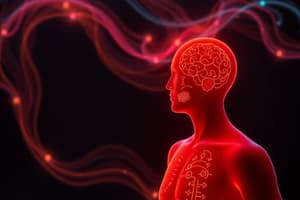Podcast
Questions and Answers
What is the primary function of the control center in a homeostatic mechanism?
What is the primary function of the control center in a homeostatic mechanism?
- To send instructions to effectors (correct)
- To absorb nutrients
- To detect changes in the environment
- To maintain the body’s internal stability
Which of the following is an example of a homeostatic mechanism?
Which of the following is an example of a homeostatic mechanism?
- Blood glucose regulation (correct)
- Nutrient absorption
- Cell division
- Muscle contraction
Negative feedback in homeostasis is best described as:
Negative feedback in homeostasis is best described as:
- Causing a change in the same direction as the stimulus
- Enhancing the original stimulus
- Maintaining a constant internal environment
- Causing a change in the opposite direction of the stimulus (correct)
What type of solution causes a cell to swell and potentially lyse?
What type of solution causes a cell to swell and potentially lyse?
Facilitated diffusion requires:
Facilitated diffusion requires:
Which type of transport requires energy?
Which type of transport requires energy?
What is the role of Schwann cells in axonal regeneration?
What is the role of Schwann cells in axonal regeneration?
During an action potential, depolarization occurs primarily due to:
During an action potential, depolarization occurs primarily due to:
Flashcards are hidden until you start studying
Study Notes
Homeostatic Mechanisms and Control Centers
- Control center's primary function is to send instructions to effectors in response to changes.
- Homeostasis involves maintaining the body's internal stability, crucial for health.
Examples of Homeostatic Mechanisms
- Blood glucose regulation is a key example of a homeostatic mechanism, ensuring stable energy levels in the body.
Negative Feedback in Homeostasis
- Negative feedback functions to cause a change in the opposite direction of the stimulus, helping to restore balance.
Cell Behavior in Different Solutions
- Hypotonic solutions lead to cell swelling and potential lysis due to water influx.
Diffusion and Movement Across Membranes
- Facilitated diffusion requires both carrier proteins and a concentration gradient to aid molecule transport.
- Active transport necessitates energy input, distinct from passive transport methods.
Role of Schwann Cells
- Schwann cells are critical in axonal regeneration by secreting growth factors and guiding axon regrowth, contributing to repair processes.
Action Potential and Ion Movement
- Depolarization in action potentials mainly occurs due to the influx of sodium ions entering the cell, initiating the nerve signal.
Neurotransmitters Functionality
- At the synapse, neurotransmitters are essential for carrying messages across the synaptic cleft, facilitating communication between neurons.
Parasympathetic Nervous System Effects
- The parasympathetic nervous system primarily decreases heart rate and promotes digestion, contrasting with the sympathetic nervous system's "fight or flight" response.
Studying That Suits You
Use AI to generate personalized quizzes and flashcards to suit your learning preferences.




